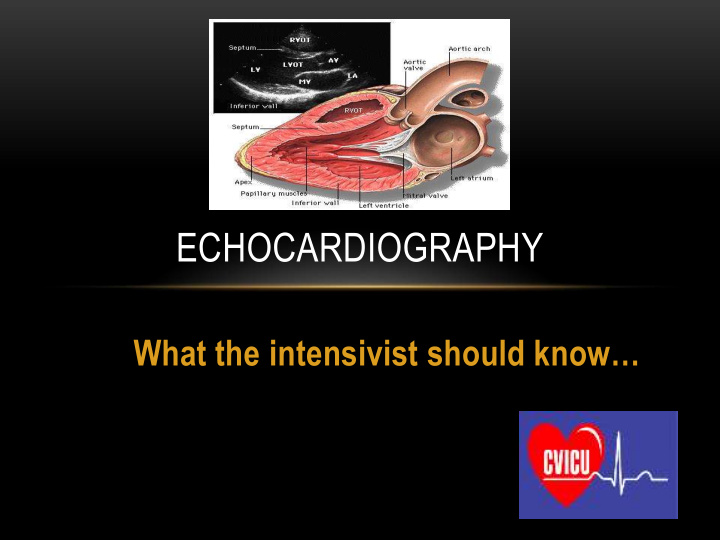



ECHOCARDIOGRAPHY What the intensivist should know…
OVERVIEW • Background • Why ECHO? • Limitations • How to learn ECHO • What you need to know • Where we are heading
BACKGROUND
BACKGROUND
COLLEGE AKNOWLEDGEMENT
WHY DO WE NEED TO LEARN ECHO? • Filling the void • Differentiating shock • Tamponade post cardiac surgery • Management of cardiovascular supports • ECHO in cardiac arrest
LIMITATIONS • Scope of practice • Impact of • False positives • False negatives • Formal studies • Advanced studies
HOW TO LEARN ECHO • BOOKS • COURSES • WEBSITES • HANDS ON SACNNING • SUPERVISION • POST GRAD CERT/DIPLOMA
WEBSITES
CICM GUIDELINE • Attend an approved ECHO course • Find a supervisor • Perform 35 focussed cardiac ultrasound cases • Record images/ Write in notes • Complete and pass an online MCQ exam @CICM • In the furture- there may be a ‘live’ exam
CICM GUIDELINE • Basic physics • Machine setup • Patient details • Image optimization • Basic views (PLA/ PSA/ A4C/ Scand IVC) • Focussed questions looking for pathology • Limitations • Colour/Doppler not included
CICM GUIDELINE- FOCUSSED QUESTIONS • 1. Is the LV significantly impaired? • 2. Is the LV dilated? • 3. Is the RV function grossly abnormal? • 4. Is the RV dilated? • 5. Is there any pericardial fluid/tamponade? • 6. Is the patient significantly hypovolaemic? • 7. Conclusion addressing relevant clinical question
SHOCK ALGORITHM • Assess volume status exclude hypovolaemia • IVC • LV EDV • Assess contractility of LV exclude LV failure • Exclude tamponade • Assess right heart function exclude PE • Exclude pneumothorax • Exclude AAA ……..takes about 3 minutes….
CARDIAC WINDOWS • Parasternal • Long axis • Short Axis • Apical • 4 chamber • 2 chamber • Subcostal
PROBE POSITION • Parasternal Long Axis
PARASTERNAL LONG AXIS
PARASTERNAL LONG AXIS
PARSTERNAL SHORT AXIS
PARASTERNAL SHORT AXIS
PSAX
PARASTERNAL SHORT AXIS
APICAL 4 CHAMBER
APICAL 4 CHAMBER
APICAL 4 CHAMBER
APICAL 2 CHAMBER
APICAL 2 CHAMBER
SUBCOSTAL
SUBCOSTAL VIEW
SUBCOSTAL
LV CONTRACTILITY • Overview • Visual ‘Gestalt’ • Fractional area change (FAC) (40-60%) • Simpsons method • Mild impairment EF 50-70% • Moderate impairment EF 30-50% • Severe impairment EF <30%
LV CONTRACTILITY- NORMAL
LV CONTRACTILITY- NORMAL
LV CONTRACTILITY- NORMAL
LV CONTRACTILITY- NORMAL
LV CONTRACTILITY- NORMAL
SIMPSONS
SIMPSONS
THE RIGHT VENTRICLE • Shape • Size • Function • Assesment
VOLUME AND PRESSURE OVERLOAD
RV/LV RATIO- NORMAL (0.6:1)
CLASSIC SIGNS OF PE • Dilated RV • Septal flattening • Impaired RV • Tricuspid regurgitation • McConnels sign • Raised PA pressures (RVSP) • Visible clot
SEPTAL FLATTENING
SEPTAL FLATTENING
SEPTAL FLATTENING
VOLUME STATUS- IVC IVC • • Abdominal probe • Sub-costal view- longitudinal • Using liver as a window • Measure IVC 2cm distal to diaphragm • Collapsibility with respiration • Visual gestalt • M-mode
IVC DIAMETER AND CVP
IVC
IVC
IVC ANALYSIS • Absolute diameter • <1cm Correlates with a CVP ~ <5cm H20 • 1-2cm Correlates with a CVP ~ 5-15cm H20 • >2cm correlates with a CVP ~ >15cm H20 • Variability • Ventilated patient • >12% collapsibility indicates volume responsiveness • Unventilated patient • >50% collapsibility indicates volume responsiveness
VOLUME STATUS-IVC
Recommend
More recommend